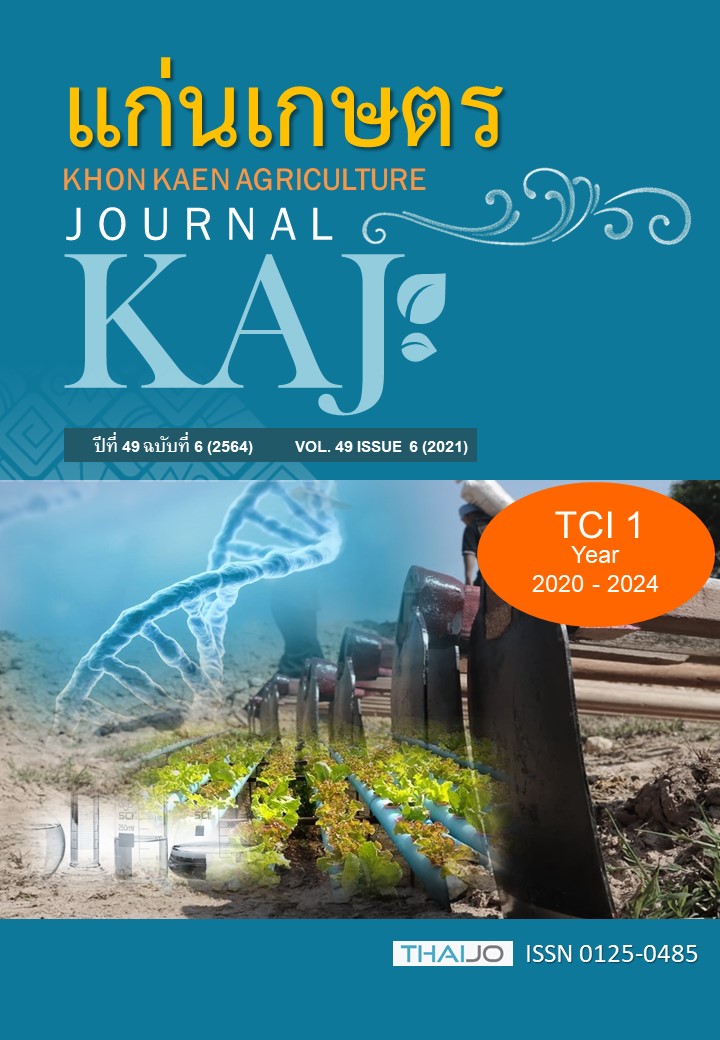การคัดเลือกเชื้อแบคทีเรียปฏิปักษ์ที่มีฤทธิ์กว้างสำหรับควบคุมโรคขอบใบแห้งและโรคเชื้อราที่ติดมากับเมล็ดพันธุ์ข้าวในห้องปฏิบัติการ
Main Article Content
บทคัดย่อ
งานวิจัยนี้มีวัตถุประสงค์เพื่อคัดเลือกเชื้อแบคทีเรียปฏิปักษ์ที่สามารถควบคุมได้ทั้งเชื้อแบคทีเรียสาเหตุโรคขอบใบแห้ง และเชื้อราสาเหตุโรคที่ติดมากับเมล็ดพันธุ์ข้าว ดำเนินงานทดลองโดยนำเชื้อแบคทีเรียปฏิปักษ์ 11 ไอโซเลตได้แก่ Streptomyces-PR87, Streptomyces-PR15, Bacillus-MS4, Bacillus-Ba029, Bacillus-S32, Bacillus-Ba033, Bacillus-NTS3, Bacillus-BS, Bacillus-BK, Bacillus-PSK และ Bacillus-Ba037N มาทดสอบความสามารถในการยับยั้งเชื้อ Xanthomonas oryzae pv. oryzae (Xoo) สาเหตุโรคขอบใบแห้งของข้าวจำนวน 4 ไอโซเลต และเชื้อราสาเหตุโรคข้าวที่ติดมากับเมล็ดพันธุ์ จำนวน 7 ไอโซเลตได้แก่ Fusarium fujikuroi -FURS017, Fusarium proliferratum -FUSR002, Fusarium spp.-FUSR021 , Bipolaris oryzae -BiKD5, Curvularia lunata -CurRD, Alternaria padwickii -AlKD5 และ Rhizoctonia oryzae-Rhi-SMN1 โดยวิธี dual culture bioassay พบว่า เชื้อแบคทีเรียปฏิปักษ์ที่มีฤทธิ์ควบคุมเชื้อสาเหตุโรคพืชได้ทุกไอโซเลตที่นำมาทดสอบ มี 7 ไอโซเลตได้แก่ Bacillus-MS4, Bacillus-Ba029, Bacillus-S32, Bacillus-Ba033, Bacillus-NTS3, Bacillus-BS และ Bacillus- BK ส่วนเชื้อ Streptomyces-PR87, Streptomyces-PR15 มีประสิทธิภาพรองลงมา คือยับยั้ง Xoo. ทั้ง 4 ไอโซเลต และยับยั้งเชื้อรา F. fujikuroi- FURS017, Fusarium sp.- FUSR021, B. oryzae-BiKD5, C. lunata-CurRD, A. padwickii-AlKD5 ได้อย่างชัดเจนแต่ยับยั้งการเจริญเส้นใย Fusarium spp.-FUSR002 และ R. oryzae-Rhi-SMN1 ได้เล็กน้อย ส่วน Bacillus-Ba037N และ Bacillus-PSK จัดเป็นเชื้อปฏิปักษ์ที่มีความสามารถต่ำ ยับยั้งเชื้อราสาเหตุโรคได้บางไอโซเลต และไม่ยับยั้งเชื้อ Xoo. และเชื้อรา F. fujikuroi- FURS017, Fusarium proliferratum -FUSR002 และเชื้อ R. oryzae-Rhi-SMN1 ดังนั้นเชื้อปฏิปักษ์ที่คัดเลือกไว้ศึกษาวิจัยต่อไป ได้แก่ Bacillus-MS4, Bacillus-Ba029, Bacillus-S32, Bacillus-Ba033, Bacillus-NTS3, Bacillus-BS, Bacillus- BK, Streptomyces-PR87 และStreptomyces-PR15 สำหรับควบคุมโรคข้าวที่สำคัญหลายชนิดโรคและลดเปอร์เซ็นต์โรคที่ติดไปกับเมล็ดพันธุ์ข้าว
Article Details

อนุญาตภายใต้เงื่อนไข Creative Commons Attribution-NonCommercial-NoDerivatives 4.0 International License.
เอกสารอ้างอิง
นันทภัค เกตุสุวงษ์ และ เพชรรัตน์ ธรรมเบญจพล. 2562. การคัดเลือกเชื้อแบคทีเรียปฏิปักษ์ที่มีศักยภาพสูงในการควบคุมโรคเหี่ยว สเคลอโรเตียม และช่วยส่งเสริมการเจริญเติบโตของต้นมะเขือเทศ. แก่นเกษตร. 47: 819-828.
ปภัสสร สีลารักษ์. 2560. ประสิทธิภาพของเชื้อ Streptomyces-PR15 และ Streptomyces-PR87 ในการควบคุมโรคจากเชื้อราที่ติดมากับเมล็ดพันธุ์และส่งเสริมการเจริญเติบโตต้นกล้าข้าว. วิทยานิพนธ์ปริญญาวิทยาศาสตรมหาบัณฑิต มหาวิทยาลัยขอนแก่น.
ปภัสสร สีลารักษ์ และ เพชรรัตน์ ธรรมเบญจพล. 2559. การถ่ายทอดทางเมล็ดพันธุ์ของเชื้อราฟิวซาเรียมสาเหตุโรคถอดฝักดาบของข้าวและศักยภาพของเชื้อ Streptomyces-PR15 และ Streptomyces-PR87 ในการควบคุมโรคจากเชื้อฟิวซาเรียมของพืชเศรษฐกิจ. แก่นเกษตร. 44: 238-245.
ยลธิดา ชนะชัย และ เพชรรัตน์ ธรรมเบญจพล. 2563. การคัดเลือกเชื้อแบคทีเรียปฏิปักษ์ที่ควบคุมเชื้อสาเหตุโรคแอนแทรคโนสพริกในแนวกว้างและช่วยส่งเสริมการเจริญเติบโตของพืช. แก่นเกษตร. 44: 238-245.
เพชรรัตน์ ธรรมเบญจพล. 2545. Streptomyces อีกมิติหนึ่งของการควบคุมโรคพืชโดยชีววิธี. แก่นเกษตร. 30: 20-27.
ภัทรกร ภูริชินาวุฒิ. 2548. พันธุศาสตร์โมเลกุลของเชื้อ Streptomyces spp. ที่ยับยั้งการเจริญของเชื้อแบคทีเรีย Acidovorax avenae subsp. citrulli และเชื้อรา Didymella bryoniae. วิทยานิพนธ์ปริญญาวิทยาศาสตรมหาบัณฑิต มหาวิทยาลัยขอนแก่น.
รัติกาล ยุทธศิลป์. 2558. การควบคุมโรคแอนแทรกโนสและรากปมของพริกโดย Streptomyces sp. ปฏิปักษ์. วิทยานิพนธ์ปริญญาปรัชญาดุษฏีบัณฑิต มหาวิทยาลัยขอนแก่น.
วีรกรณ์ แสงไสย์. 2557. บทบาทของเชื้อ Streptomyces ปฏิปักษ์ในการส่งเสริมการเจริญเติบโตและกระตุ้นภูมิต้านทานโรค ไวรัส TMV ของพริก. วิทยานิพนธ์ปริญญาวิทยาศาสตรมหาบัณฑิต มหาวิทยาลัยขอนแก่น.
สำนักวิจัยและพัฒนาข้าว กรมการข้าว. องค์ความรู้เรื่องข้าว. แหล่งข้อมูล: http://www.thairiceexporters.or.th/ default_th.htm. ค้นเมื่อ 2 กุมภาพันธ์ 2561.
อัศศิริ กลางสวัสดิ์ และ เพชรรัตน์ ธรรมเบญจพล. 2556. วิธีการใช้ Streptomyces-PR87 สำหรับส่งเสริมการเจริญเติบโตของมะเขือเทศ. แก่นเกษตร. 41: 205–212.
Alekhya, G., and S. Gopalakrishnan. 2017. Biological control and plant growth-promotion traits of Streptomyces species under greenhouse and field conditions in chickpea. Journal of Agricultural Research. 6(4): 410–420.
Elizabeth, A., B. Emmert, and J. Handelsman. 1999. Biocontrol of plant disease: a (Gram-) positive perspective. Federation of European Microbiological Societies Microbiology Letters. 171: 1-9.
Elleuch, L., M. Shaaban, S. Smaoui, L. Mellouli, I. K. Rebai, L. F. B. Fguira, K. A. Shaaban, and H. Laatsch. 2010. Bioactive Secondary Metabolites from a New Terrestrial Streptomyces sp. TN262. Applied Biochemistry and Biotechnology. 162: 579-593.
Jain, A., A. Sigh, B. N. Singh, S. Singh, R.S. Upadhyay, B.K. Sarma, and H.B. Singh. 2013. Biotic stress management in agricultural crops using microbial consortium. In D.K. Maheshwari (ed.), Bacteria in Agrobiology : Disease Management. Springer-Verlag Burlin Heidelberg. 2013.
Pirkko, H., G. Aktuganov, N.F. Galimzyanova, and A. Melent. 2001. Lytic enzyme complex of an antagonistic Bacillus sp. X-b: Isolation and purification of components. Journal of chromatography biomedical sciences and applications. 758: 197-205.
IRRI. 2010. International Rice Research Institute, Rice Fact Sheet, Bacterial Blight. March 2010.
Kabir, L., W. K. Sang, S.K. Yun, and S.L. Youn. 2012. Application of rhizobacteria for plant growth promotion effect and biocontrol of anthracnose Caused by Colletotrichum acutatum on pepper. Mycobiology. 40: 244-251.
Kakar, K.U., X.X. Ren, Z. Nawaz, Z.O. Cui, B. Li, G.L. Xie, M.A. Hassan, E. Ali, and G.C. Sun. 2016. A consortium of rhizobacterial strains and biochemical growth elicitors improve cold and drought stress tolerance in rice. Plant Biology. 18: 471-483.
Mannanov R. N., and R.K. Sattarova. 2001. Antibiotics produced by Bacillus bacteria chemistry of natural compounds. Chemistry of Natural Compounds. 37: 117-123.
Martina, K., E. M. Ramadan, M. Adam, M. Cardinale, J. Hallmann, H. Heuer, K. Smalla, and G. Berg. 2013. Bacillus and Streptomyces were selected as broad-spectrum antagonists against soilborne pathogens from arid areas in Egypt. Federation of European Microbiological Societies Microbiology Letters. 342: 168-178.
Olanrewaju, O.S. and O.O. Babalola. 2019. Bacterial consortium for improved maize (Zea mays L.) production. Microorganisms. 7: 519.
Santoyo, G., P. Guzman-Guzman, F. I. Parra-Cota, S.d. l. Santos-Villalobos, M.d C. Orozco-Mosqueda, and B.R. Grick. 2021. Plant growth stimulation by microbial consortia. Agronomy. 11: 219.
Sheng, J.X. and B.S. Kim. 2014. Biocontrol of Fusarium Crown and Root Rot and Promotion of Growth of Tomato by Paenibacillus Strains Isolated from Soil. Mycobiology. 42(2): 158-166.
Simonas, S., A. K. Cergius, D. Janusaukaite, and D. Citavicius. 2014. Bacteria with a broad-spectrum of antagonistic activity against pathogenic fungi of cereals. Federation of European Microbiological Societies Microbiology Letters. 101: 185-192.
Zeidan, R., Z. Ul-Hassan, R. Al-Thani, G. Migheli, and S. Jaoua. 2019. In-Vitro application of a Qatari Burkholderia cepacia strain (QBCO3) in the biocontrol of mycotoxigenic fungi and in the reduction of Ochratoxin A. biosynthesis by Aspergillus carbonarius. Toxins. 11: 700.


